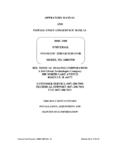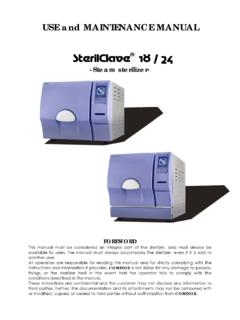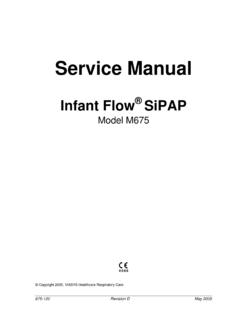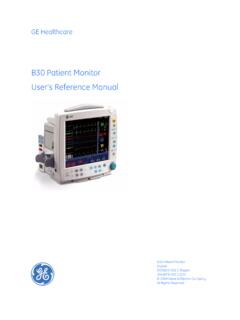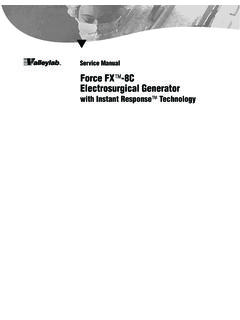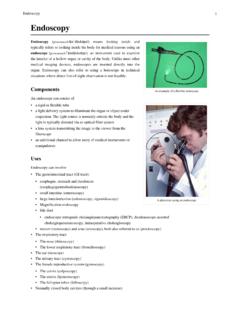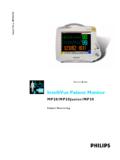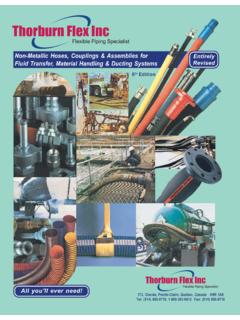Transcription of Peristaltic pump - Frank's Hospital Workshop
1 Peristaltic pump 1. Peristaltic pump A Peristaltic pump, or roller pump, is a type of positive displacement pump used for pumping a variety of fluids. The fluid is contained within a flexible tube fitted inside a circular pump casing (though linear Peristaltic pumps have been made). A rotor with a number of "rollers", "shoes" or "wipers" attached to the external circumference compresses the flexible tube. As the rotor turns, the part of tube under compression closes (or "occludes") thus forcing the fluid to be pumped to move through the tube. Additionally, as the tube opens to its natural state after the passing of the cam ("restitution" or "resilience") fluid flow is induced to the pump.
2 This process is called peristalsis and used in many biological systems such as the gastrointestinal tract. 360 Degree Peristaltic Pump Applications Peristaltic pumps are typically used to pump clean/sterile or aggressive fluids, because cross contamination cannot occur. Some common applications include pumping IV fluids through an infusion device, aggressive chemicals, high solids slurries and other materials where isolation of the product from the environment, and the environment from the product, are critical. The Peristaltic pump is the standard method for introducing liquids into the nebulizer on an inductively coupled plasma mass spectrometry (ICP-MS) or Inductively Coupled Plasma Atomic Emission Spectroscopy (ICP-OES) unit.
3 Rotary Peristaltic pump Key Design Parameters Chemical Compatibility The pumped fluid contacts only the inside surface of the tubing. There are no other valves, O-rings, seals or packings to worry about in a Peristaltic pump. Therefore, the only compatibility to worry about in a Peristaltic pump is the tubes for the fluid being pumped. Of all the design parameters, the compatibility is the first one that need to be considered. Linear Peristaltic pump The tubing need to be elastomeric to maintain the circular cross section after millions of cycles of squeezing in the pump. This requirement eliminates a variety of non-elastomeric polymers that have compatibility with a wide range of chemicals, such as PTFE, polyolefins, PVDF etc.
4 From consideration as material for pump tubing. The popular elastomers for pump tubing are silicone, PVC, EPDM+polypropylene (as in Santoprene), polyurethane and Neoprene. Of these materials, the EPDM+polypropylene (-prenes) have the best fatigue resistance and a wide range of chemical compatibility. Silicone is popular with water-based fluids, such as in Bio-pharma industry, but have limited range of chemical compatibility in other industries. Extruded fluoroplymer tubes such as FKM (Viton, Fluorel, etc.) have good compatibility with acids, hydrocarbons, and petroleum fuels. But the material has insufficient fatigue resistance to get achieve an effective tube life.
5 Peristaltic pump 2. There are a couple of newer pump tubing developments that offer a broad chemical compatibility - a lined tubing approach and the use of fluoroelastomer approach. Tubes like Chem-Durance [1], Pharmed [2], Pharma-Pure [3], Solve-Flex [4] and Smart-Shield [5] take the lined tubing approach, whereas CHEM-SURE [6] and GORE High-Resilience Tubing Style 400 [7] take the fluoroelastomer approach. With the lined tubing, the thin inside liner is made of a chemically resistant material such as poly-olefin and PTFE. that form a barrier for the rest of the tubing wall from coming in contact with the pumped fluid.
6 These liners are materials that are not elastomeric, therefore the entire tube wall cannot be made with this material for Peristaltic pump applications. These tubing provide adequate chemical compatibility and life to use them in chemically challenging applications. There are a few things to keep in mind when using these tubes - any pin holes in the liner during manufacturing could render the tubing vulnerable to chemical attack. In the case of stiff plastic liners like the polyolefins, with repeated flexing in the Peristaltic pump they can develop cracks, rendering the bulk material again vulnerable to chemical attack.
7 A common issue with all lined tubing is delamination of the liner with repeated flexing that signal the end of that tube life. For those with need for chemically compatible tubing, these lined tubing offer a good solution. With the fluoroelastomer tubing, the elastomer itself has the chemical resistance. In the case of Chem-Sure, it is made of a perfluoroelastomer, that has the broadest chemical compatibility of all elastomers. The two fluoroelastomer tubes listed above combine the chemical compatibility with a very long tube life stemming from their reinforcement technology, but come at a pretty high initial cost.
8 One has to justify the cost with the total value derived over the long tube life, and compare with other options such as other tubing or even other pump technologies. There are many online sites for checking the chemical compatibility of the tubing material with the pumped fluid. Two of them are: http:/ / www. coleparmer. com/ techinfo/ ChemComp. asp http:/ / www. dupontelastomers. com/ Tech_Info/. The manufacturers of these tubing may also have compatibility charts specific to their tubing. While these charts cover a list of commonly encountered fluids, they may not have all the fluids.
9 If there is a fluid whose compatibility is not listed anywhere, then a common test of compatibility is the immersion testing. A 1 to 2. inch sample of the tubing is immersed in the fluid to be pumped for anywhere from 24 to 48 hours, and the amount of weight change from before and after the immersion is measured. If the weight change is greater than 10% of the initial weight, then that tube is not compatible with the fluid, and should not be used in that application. This test is still a one way test, in the sense that there is still a remote chance that the tubing that passes this test can still be incompatible for the application since the combination of borderline compatibility and mechanical flexing can push the tube over the edge, resulting in premature tube failure.
10 In general, recent tubing developments have brought broad chemical compatibility to the Peristaltic pump option that many chemical dosing applications can benefit over other current pump technologies. Peristaltic pump 3. Occlusion The minimum gap between the roller and the housing determines the maximum squeeze applied on the tubing. The amount of squeeze applied to the tubing affects pumping performance and the tube life - more squeezing decreases the tubing life dramatically, while less squeezing decreases the pumping efficiency, especially in high pressure pumping. Therefore, this amount of squeeze becomes an important design parameter.
